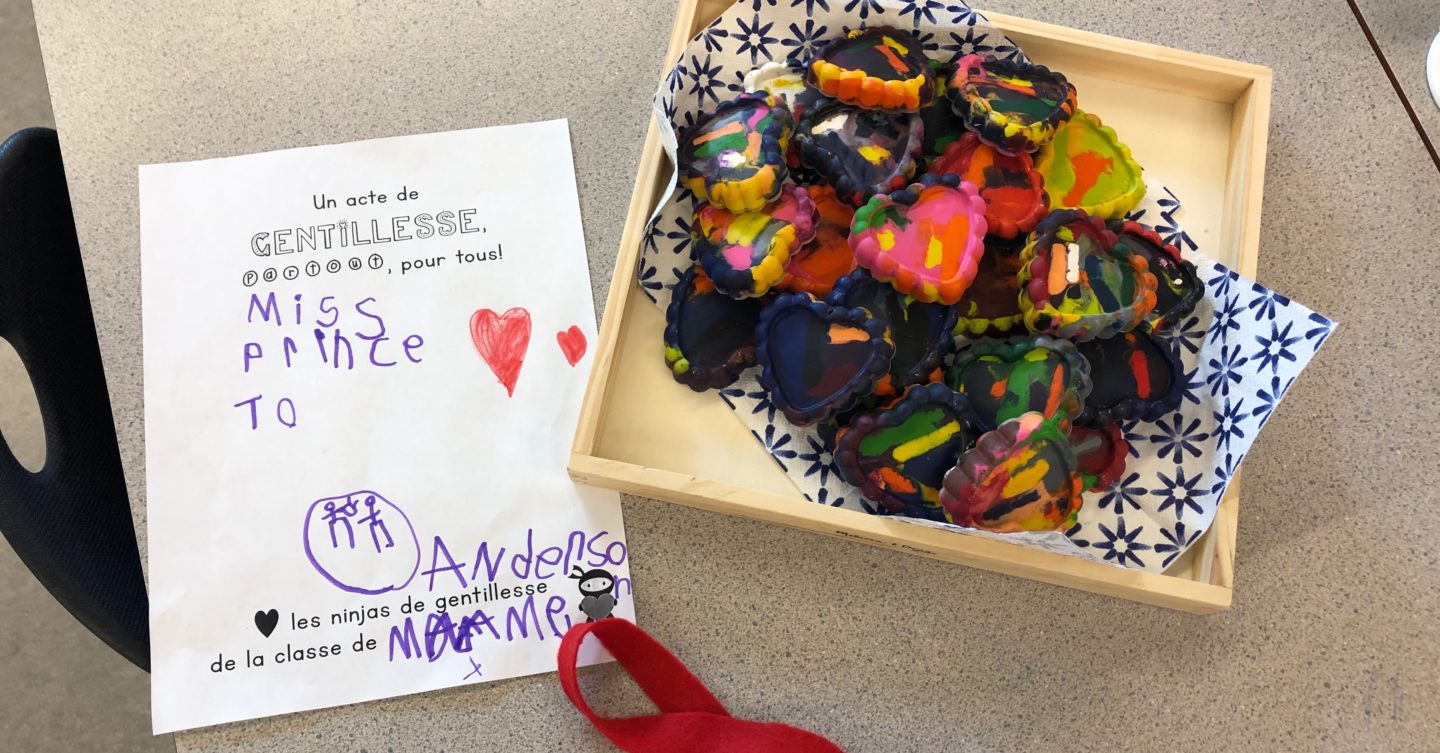
Circle of Viewpoints
To introduce this thinking routine, I connected it to our learning around kindness. Our class regularly completes “kindness missions” as kindness ninjas. We complete acts of kindness with the goal of lifting the spirits of those in our community. This focus alone goes a long way towards building empathy. The circle of viewpoints (COV) routine is the perfect pairing to enhance this learning about perspective taking.
I introduced the routine after we had already completed this kindness act. We made heart shaped crayons to gift to another class in our school. Small groups of kids had been working for ten to fifteen minutes a day to peel the paper wrappers off of our broken crayons. We soaked the crayons in water first to help release the glue. This makes for a bit of water play and sensory work. As the crayons were peeled, we put them in silicone heart shaped molds. I only had two sets of molds to make a total of twelve hearts; since we were planning to gift them to another class, we did the whole process twice. Once the molds were ready, we headed up to the oven to melt our new crayons. When they were ready, the kids helped me peel the hearts out and we admired our work. Then it was time to figure out to whom we might gift these crayons. Who would feel the most excited, cared for, surprised, etc.
Once we had all of our crayons ready to go, we made a note for the class, put on our kindness ninja headbands, and set off on our special delivery. After we got back to the classroom, I introduced the circle of viewpoints and we tried to think of everyone who was touched by our act of kindness, or who may have witnessed it. I wrote all the names down on separate notecards. Here’s what we came up with:
- Our class
- Miss Prince’s Class
- Miss Prince
- Miss Laura (EA in Miss Prince’s class)
- Verónica (Admin assistant who came to see what we were up to while we were using the oven)
- Me
- Mme Suzanne (EA who sometimes helps in our class)
Since we were sitting in circle already (as we most often do), I spread the note cards around the circle. Then, I let the kids know they could choose someone in the circle of viewpoints and think about the kindness act from their point of view. The language I used for this was « Maintenant, tu choisis une personne dans le cercle et tu penses comme si tu es la personne que tu choisis. Bouge, et assis-toi près du nom de la personne que tu choisis. »
Once we have formed our new circle, I started with the prompt « Qu’est-ce que la personne voit? » I added more prompting questions, such as « Est-ce que la personne a vu quand on a enlevé le papier sur les crayons de cire? Est-ce que la personne a vu quand on a mis les coeurs au four? » Then we moved on to « Qu’est-ce que la personne pense? » et « Qu’est-ce que la personne ressent? » By the time we got to the feelings part, and someone shared that they thought I would be proud of the class (« Je pense que Madame est fière de ça. ») it prompted someone else to broaden the circle: « Et moi maman et moi papa fière. » This was particularly exciting because it is encouraging the learners to consider the ripple effects of their kindness efforts, as well as the idea that there are always more perspectives than you first think. This discovery led to the conclusion that Mrs. Holob (our principal) must also be proud of us, and Mrs. Evans (our music teacher), and Mrs. Powell (our teacher librarian), and Ms. J (our physical education teacher).
What I love about this thinking routine is that it provides an opportunity to practice perspective taking before there is a problem. Too often, young learners aren’t prompted to consider how others might feel until after they have wronged said person. This way, we all get a chance to consider the viewpoints surrounding a shared experience. Additionally, this routine pushes us to consider and identify additional viewpoints and perspectives on an event, issue, or topic.

Here’s a simple visual image I created to use when first introducing and teaching this routine. When I first introduce the COV thinking routine, we work together as a whole group. While this routine can be used to explore events, issues, or topics, I have only used it surrounding specific events (or video clips). As my learners gain more practice with this routine, I may be able to extend our use of this routine even further. Again, I find it really helpful to use an image to draw attention to the type of thinking we are doing and to focus our thinking. Please feel welcome to download this image for your use in your classroom.
